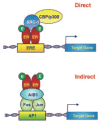The role of maintenance proteins in the preservation of epithelial cell identity during mammary gland remodeling and breast cancer initiation
- PMID: 23845141
- PMCID: PMC3935006
- DOI: 10.5732/cjc.013.10040
The role of maintenance proteins in the preservation of epithelial cell identity during mammary gland remodeling and breast cancer initiation
Abstract
During normal postnatal mammary gland development and adult remodeling related to the menstrual cycle, pregnancy, and lactation, ovarian hormones and peptide growth factors contribute to the delineation of a definite epithelial cell identity. This identity is maintained during cell replication in a heritable but DNA-independent manner. The preservation of cell identity is fundamental, especially when cells must undergo changes in response to intrinsic and extrinsic signals. The maintenance proteins, which are required for cell identity preservation, act epigenetically by regulating gene expression through DNA methylation, histone modification, and chromatin remodeling. Among the maintenance proteins, the Trithorax (TrxG) and Polycomb (PcG) group proteins are the best characterized. In this review, we summarize the structures and activities of the TrxG and PcG complexes and describe their pivotal roles in nuclear estrogen receptor activity. In addition, we provide evidence that perturbations in these epigenetic regulators are involved in disrupting epithelial cell identity, mammary gland remodeling, and breast cancer initiation.
Figures





Similar articles
-
Differential expression of genes involved in the epigenetic regulation of cell identity in normal human mammary cell commitment and differentiation.Chin J Cancer. 2014 Oct;33(10):501-10. doi: 10.5732/cjc.014.10066. Epub 2014 Sep 16. Chin J Cancer. 2014. PMID: 25223915 Free PMC article.
-
CpG island structure and trithorax/polycomb chromatin domains in human cells.Genomics. 2012 Nov;100(5):320-6. doi: 10.1016/j.ygeno.2012.07.006. Epub 2012 Jul 20. Genomics. 2012. PMID: 22819920 Free PMC article.
-
PcG and trxG in plants - friends or foes.Trends Genet. 2015 May;31(5):252-62. doi: 10.1016/j.tig.2015.03.004. Epub 2015 Apr 6. Trends Genet. 2015. PMID: 25858128 Review.
-
The epigenetic landscape of mammary gland development and functional differentiation.J Mammary Gland Biol Neoplasia. 2010 Mar;15(1):85-100. doi: 10.1007/s10911-010-9170-4. Epub 2010 Feb 17. J Mammary Gland Biol Neoplasia. 2010. PMID: 20157770 Free PMC article. Review.
-
Mechanisms of Regulation of Cell Fate in Breast Development and Cancer.Adv Exp Med Biol. 2025;1464:167-184. doi: 10.1007/978-3-031-70875-6_10. Adv Exp Med Biol. 2025. PMID: 39821026 Review.
Cited by
-
Molecular pathways involved in pregnancy-induced prevention against breast cancer.Front Endocrinol (Lausanne). 2014 Dec 10;5:213. doi: 10.3389/fendo.2014.00213. eCollection 2014. Front Endocrinol (Lausanne). 2014. PMID: 25540638 Free PMC article. Review.
-
DHHC protein family targets different subsets of glioma stem cells in specific niches.J Exp Clin Cancer Res. 2019 Jan 18;38(1):25. doi: 10.1186/s13046-019-1033-2. J Exp Clin Cancer Res. 2019. PMID: 30658672 Free PMC article.
-
Potential Therapeutic Application of Estrogen in Gender Disparity of Nonalcoholic Fatty Liver Disease/Nonalcoholic Steatohepatitis.Cells. 2019 Oct 15;8(10):1259. doi: 10.3390/cells8101259. Cells. 2019. PMID: 31619023 Free PMC article. Review.
-
Oncofetal Epigenetic Bivalency in Breast Cancer Cells: H3K4 and H3K27 Tri-Methylation as a Biomarker for Phenotypic Plasticity.J Cell Physiol. 2016 Nov;231(11):2474-81. doi: 10.1002/jcp.25359. Epub 2016 Mar 10. J Cell Physiol. 2016. PMID: 26916849 Free PMC article.
References
-
- Rosen PP. Rosen's Breast Pathology. In: Rosen PP, editor. Philadelphia: Lippincott Williams & Wilkins; 2008. pp. 201–248.
-
- Smalley M, Ashworth A. Stem cells and breast cancer: a field in transit. Nat Rev Cancer. 2003;3:832–844. - PubMed
-
- Stingl J, Raouf A, Emerman JT, et al. et al. Epithelial progenitors in the normal human mammary gland. J Mammary Gland Biol Neoplasia. 2005;10:49–59. - PubMed
-
- Polyak K, Weinberg RA. Transitions between epithelial and mesen-chymal states: acquisition of malignant and stem cell traits. Nat Rev Cancer. 2009;9:265–273. - PubMed
Publication types
MeSH terms
Substances
LinkOut - more resources
Full Text Sources
Other Literature Sources
Medical
